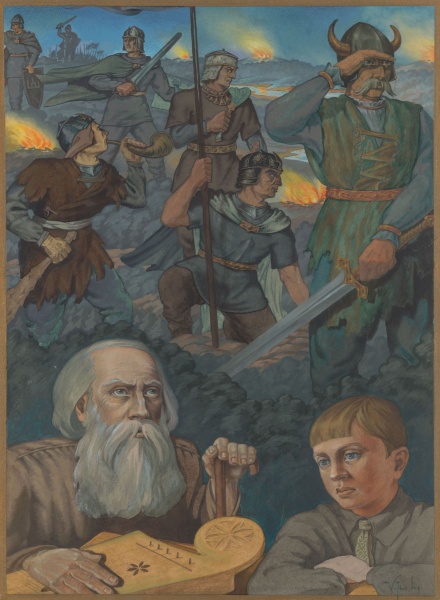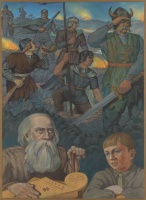
Danger
| Author: | Vilius Jomantas (1891–1960) |
Born on 22 February 1891 in Liepaja, died on 30 November 1960 in Vilnius. From 1910 to 1912, he attended the Vilnius Drawing School, from 1912 to 1914 – the School of the Art Promotion Society and the Baron Stieglitz Central Technical Drawing School in St. Petersburg, and from 1914 to 1918 – the Kiev War Academy. In 1918, having returned to Vilnius, he worked in Adomas Varnas’s painting studio and taught at a girls’ gymnasium. From 1922 to 1924, he studied at the Munich Academy of Fine Arts, and upon his return worked as a lithographer in printing houses.
In 1947–1948, he taught graphic art at the Vilnius Art Institute, and from 1948 to 1958 was deported to Siberia. He mainly worked in the field of applied graphic art – created book covers, posters, and postal stamps. His work is distinguished by abundant Lithuanian national elements and a strong influence of art deco. He made some painted and lithographed portraits of Lithuanian public figures and created some examples of decorative painting and set design.
Source: Académie de Vilna: Vilniaus piešimo mokykla 1866-1915 / Vilnius drawing school: Exhibition Catalogue, Nacionalinė dailės galerija 2017 m. 4 d. - lapkričio 26 d., compiled by Jolanta Širkaitė, Vilnius: Lietuvos kultūros tyrimų institutas, 2017, p. 204.

Born on 22 February 1891 in Liepaja, died on 30 November 1960 in Vilnius. From 1910 to 1912, he attended the Vilnius Drawing School, from 1912 to 1914 – the School of the Art Promotion Society and the Baron Stieglitz Central Technical Drawing School in St. Petersburg, and from 1914 to 1918 – the Kiev War Academy. In 1918, having returned to Vilnius, he worked in Adomas Varnas’s painting studio and taught at a girls’ gymnasium. From 1922 to 1924, he studied at the Munich Academy of Fine Arts, and upon his return worked as a lithographer in printing houses.
In 1947–1948, he taught graphic art at the Vilnius Art Institute, and from 1948 to 1958 was deported to Siberia. He mainly worked in the field of applied graphic art – created book covers, posters, and postal stamps. His work is distinguished by abundant Lithuanian national elements and a strong influence of art deco. He made some painted and lithographed portraits of Lithuanian public figures and created some examples of decorative painting and set design.
Source: Académie de Vilna: Vilniaus piešimo mokykla 1866-1915 / Vilnius drawing school: Exhibition Catalogue, Nacionalinė dailės galerija 2017 m. 4 d. - lapkričio 26 d., compiled by Jolanta Širkaitė, Vilnius: Lietuvos kultūros tyrimų institutas, 2017, p. 204.






